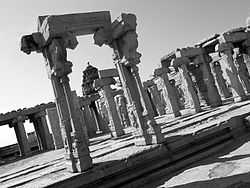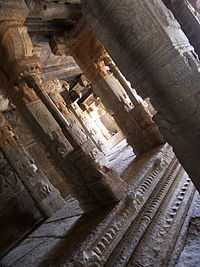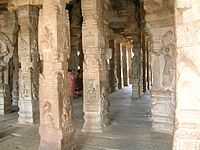Lepakshi
| Lepakshi లేపాక్షి Lai Pakshi | |
|---|---|
| Village and Mandal | |
 | |
 Lepakshi | |
| Coordinates: 13°49′N 77°36′E / 13.81°N 77.60°ECoordinates: 13°49′N 77°36′E / 13.81°N 77.60°E | |
| Country | India |
| State | Andhra Pradesh |
| District | Ananthapur |
| Population (2001) | |
| • Total | 42,101 |
| Languages | |
| • Official | Telugu |
| • Other | Telugu, Kannada, Urdu. |
| Time zone | IST (UTC+5:30) |
| PIN | 515331 |
| Vehicle registration | AP 02 [A,B,C...AB,AC..] [XXXX..4 Numbers] |
| Nearest city | Hindupur, AP |
| Climate | dry and hot (Köppen) |
Lepakshi (Telugu: లేపాక్షి) is a small village and Mandal headquarters located in the Anantapur District, in Andhra Pradesh, India. It is 15 km (9.3 mi) east of Hindupur and about 120 km (75 mi) north of Bangalore. From Bangalore, it can be reached by going west at Kodikonda checkpost on Hyderabad highway NH 7. Alternatively, one could take a bus or a train to Hindupur and then travel to Lepakshi.
Lepakshi is very important historically and archaeologically. There are three shrines dedicated to Shiva, Vishnu and Virabhadra.
_from_Lepakshi_sheltered_by_a_naga.jpg)
The famous Veerabhadra temple, dedicated to Veerabhadra, is located here. Built by the brothers Viranna and Virupanna, the temple is a notable example of the Vijayanagar architectural style.[1] It is famous for its sculptures, which were created by the artisans of Vijayanagara empire. A huge Nandi bull made out of a single granite stone is one of the attractions in Lepakshi.The place is renowned for being one of the best repository of mural paintings (see below) of the Vijayanagar Kings. Many old Kannada inscriptions dating back centuries can be seen on its walls. Legend has it that the Naga of the Nagalinga was carved out of a single stone by sculptors while they waited for their mother to prepare lunch.
Temples of Lepakshi

There are three temples dedicated to Shiva, Vishnu and Virabhadra. On a hillock known as Kurma Saila (tortoise shaped hill), temples of 'Papanatheswara', 'Raghunatha', 'Srirama', 'Veerabhadra' and 'Durga' are located. Veerabhadra temple is the most important temple.
Lepakshi is an ultimate testimony for Vishwakarma Brahmins who sculpted these temples. It is believed that noted Vishwakarma Amarashilpi Jakanachari took part in the planning the architecture of these temples. There are many shila shasanas that the famous sculptors like Dakoju, Maroju took part in this temple sculpture.@TRILOK REDDI
Points of interest in the Temple
There are many specialities in this temple like a rock chain, Vastu Purush, Padmini race Lady, the Hanging Pillar, Durga Paadam, Lepakshi saree designs etc. On the walls of this temple, several stories like the Mahabharatha, Ramayana are sculpted. On the roof are many beautiful paintings done by natural pigments. One noted spot in the temple is "Eyes of Viroopaakshanna". According to history, due to a misunderstanding with the temple's builder, the king ordered him to be blinded. Hearing this, the builder plucked out his own eyes and threw them at the wall. Even today those blood marks are evident on that particular wall.
Lepakshi Nandi
The monolithic "Nandi" sculpture which is said to be the biggest monolithic Nandi in India, is synonymous with Lepakshi. It is 4.5 m high and 8.23m long.
The big granite bull is on the main road, about 200 metres from the temple. It has been positioned such that it faces the shivalinga shielded by a huge serpent inside the temple. Said to be the second largest monolith in India, after Gomateswara, the Nandi sports a huge kaasu malai, a bell chain, earrings and other jewellery.
Gallery
-

Lepakshi Nandi
-

Lepakshi Nandi
-

Lepakshi
-

Lepakshi
-

Lepakshi Nandi
-

Lepakshi Nandi
-

Siva Painting on Temple Ceiling
-

Siva Painting on Temple Ceiling
-

Siva Painting on Temple Ceiling
-

Chaviti Vinayaka
-

Open Air Kalyana Mantapam
-

Siva Parvathi Kalyanam
-

Color Palette/Dining plate
-

Sita Amma Padam
-

Lepakshi Temple Ceiling
Website
References
- ↑ "Lepakshi". Retrieved 2006-08-18.
External links
| Wikimedia Commons has media related to Lepakshi. |
- Virabhadra Temple at Lepakshi
- Lepakshi
- Art of Lepakshi
- External Photograph of Lepakshi
- Photograph of Nandi at Lepakshi
- Photograph of Shiva Linga at Lepakshi